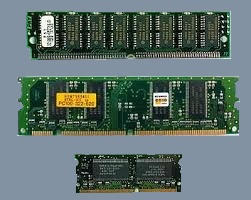


© Estwald ISI 2015 - 2025


Estwald’s
Information System Infrastructures

Memory
Motherboard manufacturers state which type, speeds, and size of memory modules
can be used in conjunction with a given motherboard. Memory type will be stated as
DDR, DDR2, DDR3, or DDR4 and voltages from 1.35v to 1.8v will be stated and they
must be followed. Speed and size are not as rigid.
The speed of addressing dynamic random access memory (DRAM) is based on
two things the clock speed in MHz and the number of clock cycles it takes for data to be
available once an address is provided. The first is denoted by numbers like 1066, 1333,
1600, 1866, 2133, et al; and higher is better. The second is labeled as Complex Adaptive
System (CAS) and takes the form 9, 12, or 20; where a lower number is better. To
calculate access speeds multiply the reciprocal of the frequency by the CAS. For instance:
(1/1,600,000,0000) * 9 = 11.25 ns (1/1,866,000,000) * 10 = 10.72 ns
As can be seen, despite the lower CAS of the 1600 it doesn’t make up for the frequency advantage of the 1866 class
module and the subsequent reduction in access time. And although speed is important, an increase in speed does not
necessarily provide an equal increase in system performance.
Memory has two purposes. First, it services storage and other slow devices. Second, it provides the L3 cache, part of the
CPU, data it anticipates it may require before the L2 requires it from the L3 cache. So long as memory can upload the data to L3
before L2 asks L3 for it all is well. Tests have shown 90% of the time a 1600 chip will be fine, with an 1866 chip having a hit rate
of nearly 99%. The 2133 chip only adds another .004%. It simply isn’t worth the higher cost of the chips except in extreme
cases.
The amount of memory required by a system depends on the number and type of applications being run both individually
and simultaneously. Modern computers set up virtual machines for each running application and the operating system controls
their activities. Each application requests a memory space to work in. If it is available the OS gives it to the application. If there is
insufficient memory for all running applications then the OS starts offloading applications from memory to a ‘Pagefile’ created on
the storage device. Moving applications between memory and the Pagefile is a slow process and it must be performed
continuously on a system without sufficient memory. In this instance, to little memory will cripple a system but too much,
although wasteful, will do no harm and the OS generally finds ways to use it. Low end workstations tend to use 4GB – 6GB of
memory where the more expensive employ 8GB – 64GB. Specialty servers can have 128 GB or more.
















